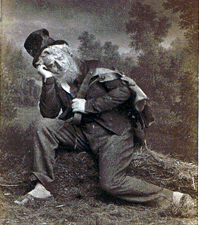Peer Gynt facts for kids
Quick facts for kids Peer Gynt |
|
|---|---|

Henrik Klausen as Peer (1876)
|
|
| Written by | Henrik Ibsen |
| Date of premiere | 24 February 1876 |
| Place of premiere | Christiania |
| Original language | Norwegian |
| Genre | Romantic dramatic poem converted into a Play |
Peer Gynt is a famous play written by Henrik Ibsen in 1867. It started as a long poem. Ibsen based the story on old Norse fairy tales collected by Peter Christen Asbjørnsen. These tales were written around 1848-1850. Ibsen wrote Peer Gynt to explore and gently question the ideas about Norwegian identity that were popular at the time.
Contents
From Poem to Stage Play
Peer Gynt was first a poem, but Ibsen later changed it into a play for the stage. A famous composer named Edvard Grieg wrote all the original music for the play. The very first show was on February 24, 1876, in Christiania, which is now called Oslo.
The Music of Peer Gynt
Grieg's music for the play had 26 different pieces. Later, in 1888 and 1891, Grieg chose eight of these pieces. He put them together into two groups, called suites, with four pieces in each. These are now known as the Peer Gynt Suites. They are very well-known and often played by orchestras around the world.
What is Peer Gynt About?
The play tells the story of Peer Gynt, a young man from a small Norwegian village. He is known for telling tall tales and being a bit of a dreamer. Peer goes on many adventures around the world. He meets many different people and creatures.
Peer's Journey and Lessons
During his travels, Peer tries to find himself and what it means to be a true person. He often makes mistakes and tries to avoid being truly himself. The story shows how his choices affect his life. It teaches lessons about honesty, self-discovery, and finding your true path.
Peer Gynt in Movies
Many movies have been made based on the story of Peer Gynt. The very first movie was made in 1915. This shows how popular and lasting the story has been for over a hundred years.
Images for kids
See also
 In Spanish: Peer Gynt para niños
In Spanish: Peer Gynt para niños





